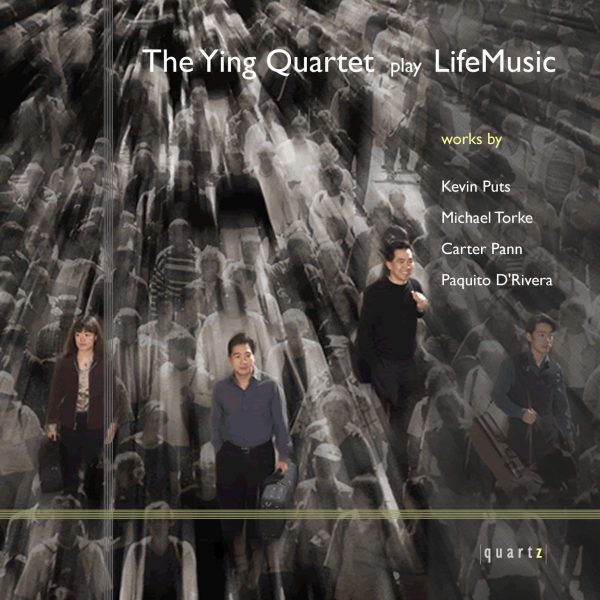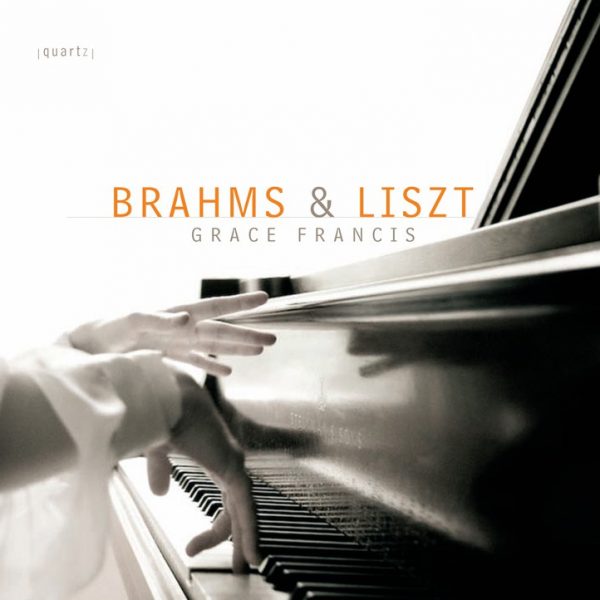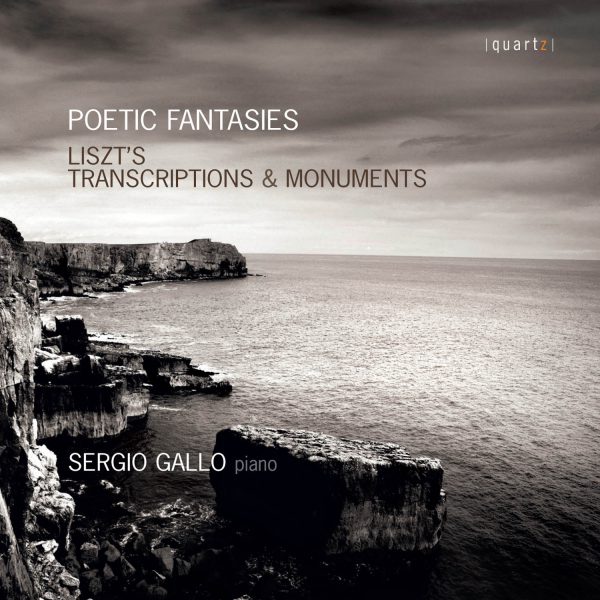Grace Francis: Consolation
Price range: £5.99 through £11.99
This album contains the two most greatly significant solo piano sonatas of the mid-nineteenth century, coincidentally composed at the same time by two of the greatest composers of the era – who, in aesthetic development and individual character, could hardly have been more different from one another, although their mutual respect is one of the least appreciated aspects of their later relationship.
Brahms’s Third Piano Sonata Opus 5 is a remarkably original work – already, in its five movements, seeking to burst the bounds of the customary four-movement structure, which the first two Sonatas had essayed. Indeed, the Third Sonata is Brahms’s largest work for solo piano and already exhibits a profound unification of the emergent Romantic movement within classical forms – an extraordinary achievement for the young composer.
Liszt’s Sonata is arguably his masterpiece for the piano – a work of such newness of utterance, so original, such a creative achievement as this work represents must have crystallised those contemporaneous divergent schools of thought which was to lead to a virtual war of words between what one might call the traditionalists and those who epitomised the ‘new music’.
About This Recording
This album contains the two most greatly significant solo piano sonatas of the mid-nineteenth century, coincidentally composed at the same time by two of the greatest composers of the era – who, in aesthetic development and individual character, could hardly have been more different from one another, although their mutual respect is one of the least appreciated aspects of their later relationship.
Franz Liszt was the elder, having been born in 1811 in the mainly German- speaking Hungarian town of Raiding, close to the Austrian border. Johannes Brahms was born in the north German port of Hamburg in 1833, but his childhood, unlike that of Liszt, was coloured by the more insalubrious aspects of city life, in some of whose bordellos the boy-pianist provided a musical background to the events he was obliged to witness.
As with all children, their earliest experiences left lasting impressions. Both boys of course were exceptionally musically gifted, but for Liszt, his father Adam’s aesthetic commitment and support (he had sung in the first performance of Beethoven’s Mass in C, conducted by the composer), the nature of travel and the child’s inherent generosity of spirit, produced – through the encouragement of the boy’s superlative gifts – a musician of wholly unique character and originality.
More than 20 years Liszt’s junior, by the time Brahms reached physical maturity, he too found himself moulded by his experiences in a very different environment. Perhaps their very different upbringing – the one, outward-looking and receptive to new ideas, the other more circumspect in his approach to human congress – affected their artistic expression, but however the personal characters of Liszt and Brahms were formed, their deep natural musicianship could not be gainsaid – encouraged, each in their own way, by both sets of parents – with the young men’s love of the piano and the immediacy of expression the instrument afforded their inspirations common to both.
Liszt’s mastery of the piano was known from an early age; his concerts and solo recitals (whether he was the instigator of the solo piano recital or not is a moot point) brought him to the forefront of European musical society. He was a colleague and enthusiastic champion of many of his contemporaries, especially Chopin and Schumann, and the early deaths of both affected him deeply. Liszt wrote and published the first biography of Chopin in 1852, three years after the Polish master’s death; in 1854, when Schumann’s mental health had seriously deteriorated, Liszt conducted Schumann’s Piano Concerto in A minor with composer’s wife Clara as soloist.
In 1838, Schumann had dedicated the revised version of his great solo piano Fantasie Opus 17 to Liszt – and in return, on the completion of his only Sonata in 1853, Liszt inscribed his B minor masterpiece to Schumann.
At that time, the early 1850s, relations between the Schumanns and Liszt were cordial; but times were changing, and not only in the Schumann household. The year of revolution, 1848, which had swept across much of Europe, found a mirror in the ‘new music’ which had begun to challenge classical precepts, and from 1850 in Weimar – where Liszt had been appointed music director of the Thuringian city (almost mid-point between Dresden, Leipzig and Nuremburg, home to Goethe and Schiller and the heartland of German Enlightenment) – the ‘new music’ Liszt promoted there eventually fell foul of traditionalists.
The traditionalists included the Schumanns and their young protégé, Johannes Brahms, who had been introduced to them through their mutual friend Joseph Joachim. Joachim was better-known as a violinist, yet he was also a composer and conductor, and, for the first few years of Liszt’s tenure in Weimar, led the city’s orchestra. However Joachim, Brahms and the Schumanns found themselves increasingly disenchanted with Liszt’s championing of the ‘new music’, into which opposing faction Brahms was to find himself drawn.
The schism was to widen later, although differences had begun to appear following Liszt conducting the premiere of Wagner’s Lohengrin in Weimar in 1850. The nervous and sensitive 20-year-old Brahms was to be introduced to Liszt in July 1853 by the violinist Eduard Reményi, during which meeting Liszt played at sight Brahms’s Scherzo Opus 4 and part of the First Sonata Opus 1. On January 7 1854, Lohengrin was given for the first time in Leipzig, following which Liszt’s first American pupil, William Mason, reported:
‘After the performance of Lohengrin, which, by the way, was successful, the whole Liszt party, by invitation, went to supper at the house of the Konzertmeister, Ferdinand David…. Brahms was also present, and during the evening he played the Andante from his F minor Sonata, Opus 5.’
In such company, and given his background, the 20-year-old may well have felt socially somewhat inferior, but any awkwardness on the young composer’s part had been largely ameliorated by the Schumanns, who provided him with the warm family atmosphere he had earlier lacked. If Brahms was socially self-conscious at this age, his inner creativity burned with a unique fire that declared the young genius in no uncertain manner.
It was surely this aspect of the young Brahms’s Sonatas that led Liszt to encourage him – and thus giving Brahms an additional spur to continue. Indeed, such is the nature of his early solo piano works (three solo Sonatas and the Scherzo), that there is nothing uncertain or uncharacteristic – in the light of his bringing to an end this clutch of early masterpieces.
Brahms’s Third Piano Sonata Opus 5 is a remarkably original work – already, in its five movements, seeking to burst the bounds of the customary four-movement structure, which the first two Sonatas had essayed. Indeed, the Third Sonata is Brahms’s largest work for solo piano and already exhibits a profound unification of the emergent Romantic movement within classical forms – an extraordinary achievement for the young composer – perhaps a musical personification of the contradictions within his character. Behind this work lies the tracery of Beethoven’s influence, and indeed the first movement contains a direct quotation from the earlier master’s Fifth Symphony – with all that that implies, including the creation of large-scale structures from tiny melodic cells and the juxtaposition of contrasting moods, yet the adherence of Brahms’s work to established sonata principles is clear.
For it is the opening displosive gesture which sets this mighty work in train, and what Brahms creates from it is little short of miraculous. Brahms’s musical logic here is astonishingly unerring and true, the result so new and impressive as to cause Schumann and Liszt to throw their weight behind the shy and outwardly immature young man whose original creativity burned fiercely within him.
The main slow movement of the work comes next, unusually headed by a poetic quotation: The evening comes, the moonlight shines, where two hearts – united in love – hold themselves blessed. For some, this image may be seen as an early precursor of Schoenberg’s Verklärte Nacht of half a century later – the mood and character of Brahms’s movement are clear – and it may well be that Schoenberg was drawn to this movement for it – most unusually – ends in a different (albeit related) key from that in which it began (Schoenberg went on to orchestrate Brahms’s G minor Piano Quartet in 1937 and ten years later wrote a famous essay, ‘Brahms the Progressive’).
As we discover in Brahms’s later masterpieces, his command of organic unity was virtually unparalleled compared with the music of his contemporaries, with self-quotation often hidden within the particular work’s texture, giving a profound sense of living organisms in time. Such creative characteristics can be discerned in this early masterpiece in sonata form.
If the first two movements have displayed contrasting spirit, the third movement, Scherzo, returns to the energy and, indeed, material of the first, optimistically exuberant. Additionally, the title of the fourth movement, an Intermezzo (Rückblick – Remembrance), reinforces the great work’s unity, for it refers to the Andante movement, as a recollection in tranquillity, a gentle emanation before leading immediately to the powerful and energetic finale, brimming with confidence within a large Rondo structure, as the music, purged of all doubt, declares the arrival of the youthful genius in no uncertain manner.
Although such evidence as we possess strongly suggests that Liszt was aware (at least partly) of Brahms’s Third Sonata, he must have been more than intrigued by the younger man’s work, having – on February 2, 1853 – completed his own single Sonata.
The two sonatas, as we have noted, are very different. In comparison with Brahms’s five-movement work, Lizst’s Sonata is in a single movement of utterly original cohesion. It has been plausibly suggested that the concept of continuous thematic transformation which the work exhibits derived from Schubert’s Wanderer Fantasy, which Liszt had transcribed for piano and orchestra in 1851. He would certainly have been aware of the inner workings of Schubert’s masterpiece at the time, and may well have determined to utilise the cross-thematic technique of that work in an extended solo composition of his own.
However it came about, Liszt’s Sonata is arguably his masterpiece for the piano – a work of such newness of utterance, so original, in every regard as to cause Clara Schumann, on receiving a copy of the music, to exclaim ‘… It really is too awful …’ She was not alone in her criticism, and the Sonata was not heard publicly until 1857 when Hans von Bülow, not Liszt, first played it in Berlin.
Since then, of course, it has come to be regarded as one of the greatest piano sonatas of the 19th-century, a work which – even today – divides opinion and analysis. Consequently, we shall not attempt an organic dissertation on the work – about which Liszt himself would not be drawn – but the comments by the great Liszt pianist and pedagogue Louis Kentner form a succinct guide for both newcomer and expert:
“In the B-minor Sonata Liszt uses the device of presenting, in a short Introduction, three seemingly incongruous elements … and then proceeds to demonstrate how these can be welded into a unity of such compactness, of such compelling power, that it convinces even the unregenerate.”
Such a creative achievement as this work represents must have crystallised those contemporaneous divergent schools of thought which was to lead to a virtual war of words between what one might call the traditionalists and those who epitomised the ‘new music’. However as we have seen in discussing Brahms’s Sonata, he – who became a symbol for the traditionalists – could embrace aspects of the Romantic movement, and Liszt was too noble a character not to encourage music by composers with whom one might, in other circumstances, feel he had little sympathy.
So these two great composers found themselves unwittingly placed as figureheads in an artistic ‘war’: yet as late as the early 1880s, when Brahms’s new Second Piano Concerto was meeting resistance from many established pianists, Brahms turned to Liszt for help in bringing the mighty work to the attention of his pupils. Selflessly, Liszt did all he could to promote Brahms’s Concerto, instinctively recognising the greatness of the music.
In terms of artistic achievement, Brahms and Liszt were comparable figures, the unifying inner genius of each composer more fully appreciated by later generations than by their contemporaries, although both composers, of course, achieved popular immortality during their lifetimes through their shorter melodic genre pieces – Brahms with his Waltzes and Hungarian Dances, Liszt with his Liesbestraume and such as the third of his Six Consolations, a set composed in 1849, with the titles taken from a set of Romantic poems by Charles Saint-Beuve. The key is D flat major, the character akin to the nocturnes of Chopin, and it may be the latter’s serious illness and death later that year led Liszt to express his feelings for his friend through the one instrument which dominated the work of virtually every great composer of the time, of which – through the music of Schumann, Chopin, Liszt and Brahms are the immortal exemplars of their age.
—Robert Matthew-Walker © 2017
Track Listing
-
Brahms 3rd Piano sonata in F minor op 5
- I. Allegro maestoso
- II. Andante espressivo
- III. Scherzo, Allegro energico
- IV. Intermezzo, Andante molto
- V. Allegro moderato ma rubato Liszt Consolation no 3 in D flat major
- Lento placido Liszt piano sonata in B minor
- I. Lento assai
- II. Andante sostenuto
- III. Allegro energico




